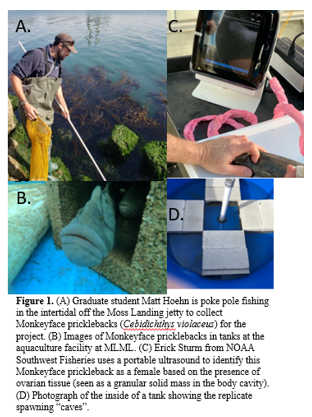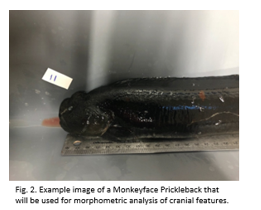DEVELOPMENT OF TECHNIQUES FOR THE CULTIVATION OF THE HERBIVOROUS MONKEYFACE PRICKLEBACK Cebidichthys violaceous AS A SUSTAINABLE ALTERNATIVE TO UNAGI
Monkeyface pricklebacks Cebidichthys violaceous are eel-like fishes in the family Stichaeidae that live in rocky intertidal and shallow subtidal habitats from Oregon to northern Baja California. The herbivorous nature of this species along with other life history characteristics, make them an attractive new species for aquaculture development in California . Their richly flavored flesh gives them potential for developing a new market as a sustainable product, and as an alternative to freshwater eels traditionally used for unagi. Our study is currently assessing their reproductive performance in captivity, as well as dietary studies to maximize growth.
Our reproductive study assesses monkeyface pricklebacks' potential for reproduction in captivity as well as conditioning of brood stock . To test spawning hypotheses, we constructed an array of 9 tanks at the MLML aquaculture center. Each environment has been implemented with different "nesting habitats". Males and female fish are placed in groups of n=8 individuals per tank and n=9 replicate tanks per treatment. By manipulating underlying substrate in these habitats and having enough of each "nest type" for every female, we can test whether Monkeyface pricklebacks have certain habitat criteria for reproduction and nesting. Sex determination in monkeyface pricklebacks is unknown . Ultrasound and Passive Integrated Transponders (PIT) tagging individuals for sex determination allowed for individual tracking in our experiment. After the conclusion of the reproduction experiments, we will examine cranial morphometrics to determine whether the size of the supraorbital crest and other features are sexually dimorphic traits. This allows us and others in the aquaculture industry to distinguish males and females when an ultrasound is not available.

